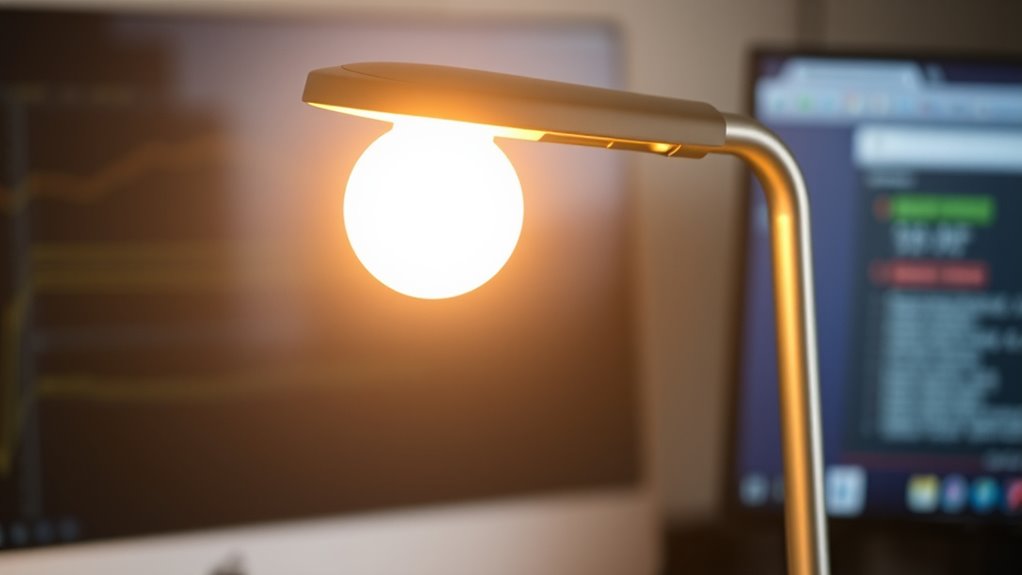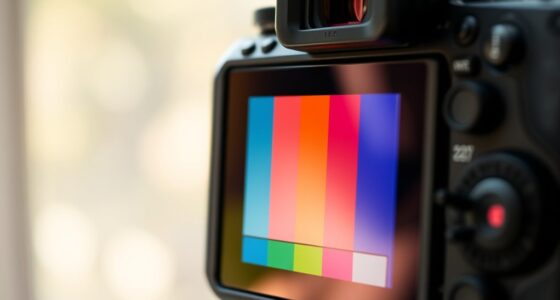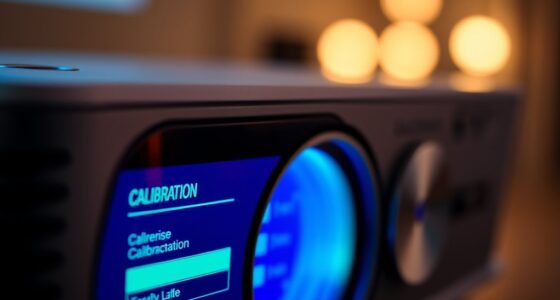Balancing brightness is key to getting great image quality while protecting your lamp’s lifespan. When you set your projector too bright, colors can look washed out, and the lamp wears out faster. Lowering brightness helps conserve energy and extends lamp life but may make images look dull if too low. The trick is finding a middle ground where scenes are clear and vibrant without harming your device. Keep exploring to discover how to fine-tune your settings for ideal results.
Key Takeaways
- Use ambient lighting to set a moderate brightness level that maintains image clarity without overworking the lamp.
- Adjust brightness gradually, aiming for natural colors and detailed images while avoiding excessive power consumption.
- Lower brightness settings extend lamp lifespan and reduce maintenance costs, especially in well-lit environments.
- Balance brightness to prevent color washout and detail loss, ensuring optimal image quality without compromising lamp durability.
- Regularly reevaluate brightness based on changing room conditions for sustained image quality and prolonged lamp life.

When adjusting the brightness on your projector or display, finding the right balance is essential. Brightness directly impacts your image quality, but cranking it up too high can have drawbacks. One of the key considerations is color accuracy. When the brightness is too intense, colors may appear washed out or overly saturated, diminishing the overall fidelity of your images. Conversely, lowering brightness might improve color richness and accuracy, but it can also lead to images that seem dull or lack detail, especially in well-lit environments. Striking this balance ensures your colors remain true to the original scene, making your viewing experience more vibrant and realistic. Additionally, you need to think about power consumption. Higher brightness levels typically demand more energy from your projector or display, which can result in increased power bills and a greater environmental footprint. If you’re using a device in a setting where energy efficiency matters, reducing brightness slightly can conserve power without substantially sacrificing image quality. This is particularly relevant for longer viewing sessions or in locations where power supply is limited.
Adjusting brightness isn’t just about making images brighter; it’s about optimizing the overall visual experience while maintaining the longevity of your device. When you set the brightness too high, you accelerate the wear and tear on the lamp, leading to shorter lamp life. This means you’ll need to replace the lamp more frequently, which can be costly and inconvenient. Proper lamp maintenance can also help extend the lifespan of your projector. On the other hand, setting the brightness too low might extend your lamp’s lifespan but at the expense of image clarity, especially in darker scenes. To find the sweet spot, start by setting the brightness at a level where colors look natural and details are clear without causing eye strain. Then, consider your environment—if it’s a dim room, lower brightness might suffice. If ambient light is strong, a higher setting could be necessary, but try to keep it as moderate as possible to avoid unnecessary power drain and prolong your lamp’s lifespan.
Ultimately, balancing brightness is a matter of compromise. You want images that are vivid and true to life, but you also want to preserve your equipment and keep power costs down. Regularly adjusting these settings based on your viewing environment and usage habits can help you achieve the perfect combination of image quality and device longevity. Remember, small tweaks can make a big difference, so don’t hesitate to experiment until you find the setting that works best for you.
Frequently Asked Questions
How Does Ambient Lighting Affect Optimal Brightness Settings?
Ambient lighting markedly impacts your ideal brightness settings. When there’s a lot of ambient light, you should increase your screen brightness to maintain good contrast and visibility. Conversely, in darker environments, lowering brightness reduces glare and eye strain. Adjusting for ambient light helps you see details clearly without overworking your lamp or sacrificing image quality. Keep an eye on screen contrast to find the perfect balance for your viewing environment.
Can Adjusting Brightness Improve Projector Lifespan Without Sacrificing Image Quality?
Imagine your projector’s lamp as a delicate flame; adjusting brightness carefully can extend its lamp durability without losing image clarity. You can lower brightness during less critical moments, preserving lamp life, while boosting it for sharp visuals. This balance prevents the lamp from overworking, maintaining ideal image quality. By managing brightness wisely, you protect your projector’s lamp, ensuring it lasts longer and continues delivering vibrant, clear images.
What Are the Signs of a Lamp Nearing End of Life?
When a lamp nears the end of its life, you’ll notice signs of lamp degradation like dimmer images, flickering, or color fading. You might also see warning messages on your projector. Don’t ignore these signals, as they indicate it’s time for bulb replacement. Addressing lamp degradation early helps maintain image quality and prevents unexpected shutdowns, ensuring your projector keeps working smoothly for longer.
How Frequently Should Brightness Be Recalibrated for Different Environments?
You should recalibrate brightness based on your environment variability, ideally every few months or when lighting conditions change considerably. Calibration frequency depends on how often your environment varies—stable settings may need less frequent adjustments, while constantly changing conditions require more frequent recalibration. Regularly checking and adjusting ensures ideal image quality without prematurely wearing out your lamp, maintaining a good balance between brightness and lamp longevity.
Are There Automatic Features That Balance Brightness and Lamp Longevity?
Many modern projectors feature automatic adjustments like auto brightness, which actively adapt to ambient light conditions. Lamp sensors continuously monitor the lamp’s status, helping the device intelligently balance brightness and longevity. These automatic features efficiently enhance image quality while extending lamp life, so you don’t have to manually tweak settings. Embrace these innovative, intuitive automatic features to optimize your viewing experience effortlessly and extend your equipment’s lifespan.
Conclusion
Remember, striking the right balance between brightness and lamp life is key to enjoying both crisp images and longer projector use. Think of it like tuning a vintage radio—you want clear sound without overdriving the tubes. By adjusting your brightness settings wisely, you guarantee your projector lasts longer, saving you time and money. So, don’t be a square—find that sweet spot and keep your visuals sharp without sacrificing your lamp’s lifespan.









